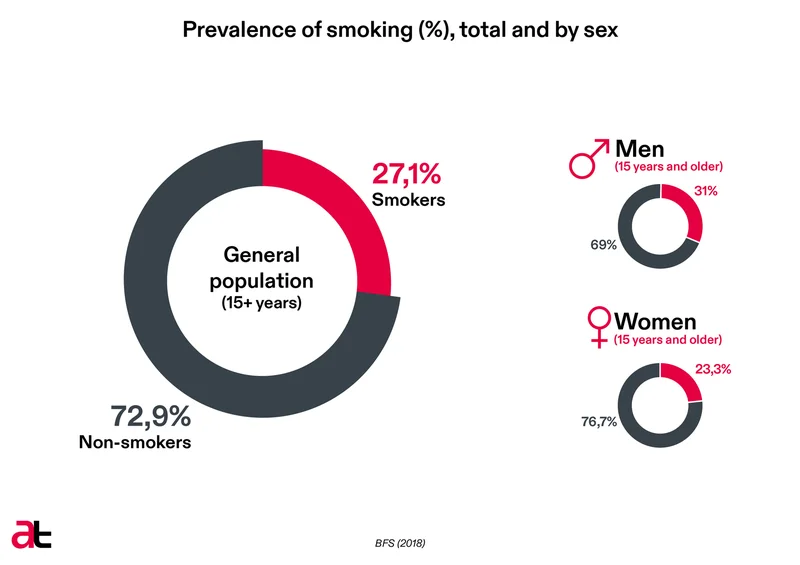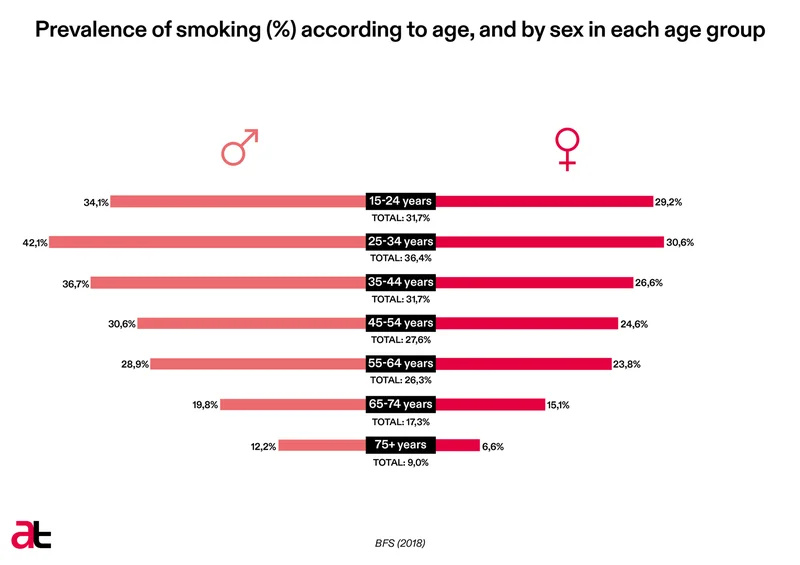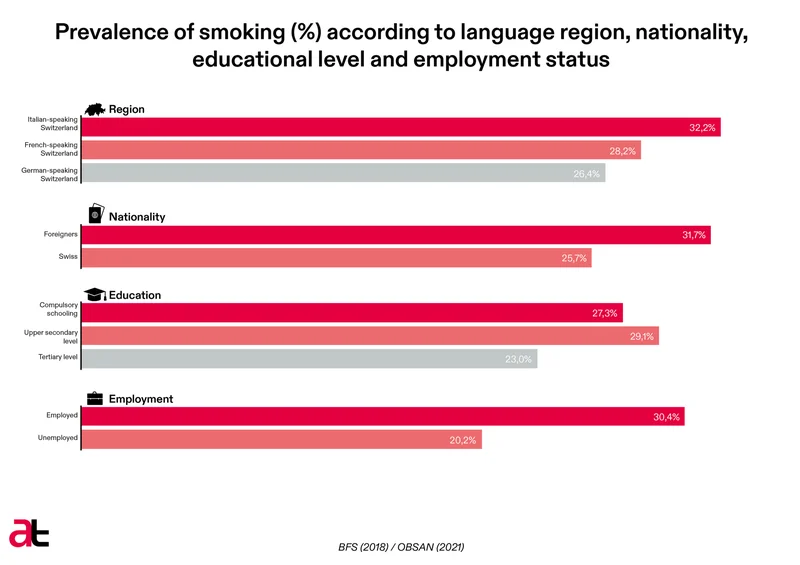The prevalence of smoking in the general population
- 27% of the population age 15 and over smokes.
- The groups with the highest rates of smoking are people under 45 years of age, men, and the lowest socioeconomic classes.
- More than two-thirds of smokers smoke daily, representing more than one person in five out of the total population 15 and over.
At the present time, the monitoring of smoking in Switzerland depends almost entirely on data collected for the Swiss health survey (ESS)[1]. These data, which are already limited by the relatively small number of questions relating to smoking in the ESS, are unfortunately in some ways subject to a systematic obsolescence, because they are collected only every five years, and the detailed estimates derived from them are available only a year or two after that. Other, older sources of data nonetheless allow for a fuller picture, which is presented in the following table.
More than a quarter of the population are smokers
In Switzerland, 27.1% of the population age 15 and up smokes, according to the most recent representative epidemiological data – data which were collected in the 2017 Swiss health survey (Figure A1A-1). However, this proportion varies significantly among different subgroups of the population, particularly as a function of age and sex, but also of other sociodemographic and economic characteristics.

Young people and men
People under age 45 and men are significantly more impacted by smoking than older adults and women.
Taking men and women together, for those under age 45 (the age groups most affected by smoking), the proportion of smokers in 2017 varied between 31.7% and 36.4%, according to their age groups (Figure A1A-2).
For all age groups taken together, slightly less than a quarter of women smoked (23.3%), as compared to 31.0% of men. For men, more than four out of 10 between the ages of 25 and 34 years old smoked. For people ages 45 to 64, the proportion of smokers was around 30%, and then declined steeply with age. For women, a similar curve was observed, with, however, a maximum that was slightly lower than for men (only slightly above 30% for women 25-34; 30.6%) and less of a clear difference among age groups for younger smokers (the proportion being around 30% for 15- to 24-year-olds and 25- to 34-year-olds).

Figure A1A-2 – Prevalence of smoking (%) according to age, and by sex in each age group, ESS 2017 (Sources OFS, 2018[3]).
Regional and socioeconomic disparities
Variations in the extent of tobacco use can also be observed among different language regions (Figure A1A-3). In 2017, Italian-speaking Switzerland (with 32.2% of smokers) exhibited a higher rate of smoking (the difference being statistically significant) than the German-speaking part of the country (26.4%); the French-speaking region had a smoking rate in-between the two (28.2%). Differences were also observed according to nationality. While Swiss nationals had a smoking rate of 25.7%, foreigners’ proportion of smokers was 31.7% (the difference being statistically significant; OBSAN, 2021[4]). Similarly, significant differences in the proportion of smokers were observed, for the over-25 age group, between those who had completed only the obligatory level of education (27.3%), those who had completed secondary II education (29.1%), and those who had a professional or graduate-level training (23.0%). The fact of being actively employed was also correlated with a higher proportion of smokers (30.4% versus 20.2% for non-employed persons; MONAM[5]).

Figure A1A-3 – Prevalence of smoking (%) according to language region, nationality, educational level, and employment status, ESS 2017 (Sources OFS, 2018[6] and *OBSAN, 2021[7])
In-depth analyses using the data from the Swiss health survey from 2012 had already uncovered a significant link between tobacco use and being young, male, having a lower educational level, and being actively employed (Thrul, 2014[8]).
A very large number of daily smokers
Daily smoking clearly surpasses occasional use. Based on the 2017 ESS study, more than two-thirds of smokers smoke daily (OBSAN, 2021[9]), or almost one person in five out of the general population age 15 and up (19.1%). For men, this proportion reaches 21.5% (as compared to 31.0% of all smokers), and for women it is 16.8% (out of 23.3% of all women), which represents more than one woman out of six age 15 and over in Switzerland.
It should be noted that analyses of the data from the CoRolAR study, which were performed for the Monitorage Suisse des addictions, highlighted the fact that the proportion of smokers was clearly higher among those with less education, especially for men (Gmel et al., 2017[10]); while 27.0% of men having completed only the nationally required level of education smoked daily, only 10.2% of men with a university or technical college education were doing this.
[1] https://www.bfs.admin.ch/bfs/de/home/statistiken/gesundheit/erhebungen/sgb.html; zuletzt besucht am 9.12.2021.
[2] https://www.bfs.admin.ch/bfs/de/home/statistiken/gesundheit/determinanten/tabak.html; zuletzt besucht am 9.12.2021.
[3] https://www.bfs.admin.ch/bfs/de/home/statistiken/gesundheit/determinanten/tabak.assetdetail.6466022.html; zuletzt besucht am 9.12.2021.
[4] https://ind.obsan.admin.ch/indicator/monam/tabakkonsum-alter-15; zuletzt besucht am 9.12.2021.
[5] https://ind.obsan.admin.ch/indicator/monam/tabakkonsum-alter-15; zuletzt besucht am 9.12.2021.
[6] https://www.bfs.admin.ch/bfs/de/home/statistiken/gesundheit/determinanten/tabak.assetdetail.6466013.html; zuletzt besucht am 9.12.2021.
[7] https://ind.obsan.admin.ch/indicator/monam/tabakkonsum-alter-15; zuletzt besucht am 9.12.2021.
[8] Thrul, Johannes (2014): Soziodemografische Einflussfaktoren auf den Substanzkonsum der Schweizer Bevölkerung – Ergebnisse der Schweizerischen Gesundheitsbefragung 2012. Sucht Schweiz. Lausanne. Download.
[9] https://ind.obsan.admin.ch/fr/indicator/monam/tabagisme-age-15; zuletzt besucht am 9.12.2021.
[10] Gmel, H.; Kuendig, Hervé; Notari, Luca; Gmel, C. (2017): Suchtmonitoring Schweiz
Konsum von Alkohol, Tabak und illegalen Drogen in der Schweiz im Jahr 2016. Sucht Schweiz. Lausanne; Download; zuletzt besucht am 9.12.2021.
AT Switzerland, September 2022